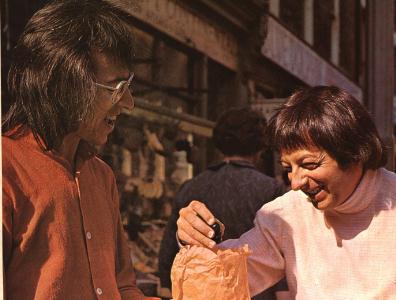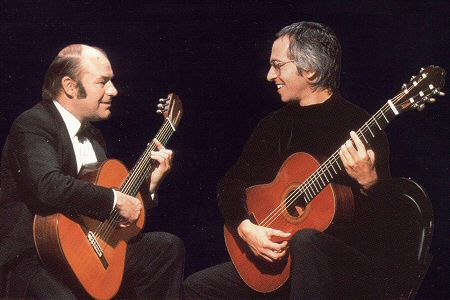 |
|
 |
 |
 |
|
|
Many of his musical friendships and collaborations have been born from his strong political views, which he makes public by being prepared to perform at fundraising and similar events. His opposition to the military putch in Greece in 1967 found voice in performances of the music of exiled Greek composer Mikis Theodorakis, with singer Maria Farandouri, which eventually found its way onto record. Similarly, the 1973 military coup in Chile caused many rally-like concerts with Inti-Illimani, whom the coup had seen exiled in Rome. Williams, together with flamenco guitarist Paco Peña, appeared as guest performers during several Inti tours during the seventies and eighties, and beyond. Len William's connections with the jazz community meant that John Williams maintained many friendships outside classical circles, and in 1969 he became the first classical musician to appear at Ronnie Scott's Jazz Club in London. His appearances there during the summer season were to continue for several years until the late 1970s, and one of the concerts in 1971 was filmed for television. He had approached Patrick Gowers and André Previn to write or develop jazz material for his own style of playing, but this idea was eventually abandoned, and the music remained the classical repertoire, including Albeniz, Tarrega and Villa-Lobos. However, one piece of music he played there was not born in the classical concert hall, but in the darkened labyrinths of the film scoring studio. In 1970, Williams met film composer and arranger Stanley Myers, who was working on the score of The Walking Stick. Myers played a short piece on the piano, which he was thinking of using as one of the motifs for the film's score, but on hearing the three bars, John immediately became excited and encouraged Myers to develop the theme, not only for the purposes of the film, but as a guitar tune. Myers took the advice, developed the tune and invited Williams to play it on the movie's soundtrack. The film isn't notable, and the piece of music didn't become famous for another decade, when it was re-used for another film. The later film was The Deer Hunter, and the piece of music: Cavatina... Since that time, Williams and the piece have been inextricably linked, an association of which he is evidently proud, having recorded it on no less than four separate occasions.

Although the Patrick Gowers and André Previn hoped-for arrangements to play at Ronnie Scott's did not materialise, both composers did write pieces for John Williams, both including parts for electric guitar; the Previn Guitar Concerto was permiered at the Royal Festival Hall in London with the London Symphony Orchestra on 25th November 1971, while Patrick Gowers' first appeared on record at the beginning of 1972. Patrick Gowers was to work with John Williams again in the future, premiering his Rhapsody for Guitar and Organ in January 1974 at the St. Alban's Organ Fesitval, and later working together on the soundtrack for Stevie in 1978. Early 1973 saw a further development in John Williams' "pop" sensibilities, when he returned to Abbey Road Studios to record The Height Below with Beatles supremo George Martin at the helm. The result was a fusion of all styles, from classical, through Jazz, to pop, linked by far-eastern undertones. The main focus of the recording was the Emperor Nero Suite, written at John Williams' commission by Brian Gascgoine, most famous at the time as Stomu Yamash'ta's keyboards player. The album also included one of the first compositions by John Williams himself, the unadventerously-named El Tuno. Following release of the album in May 1973, he embarked upon a UK tour with this material, appearing as "John Williams and Friends", with Brian Gascgoine, Carlos Bonnell (who had only just been named Williams' successor in charge of the Guitar department at the Royal College of Music), Morris Pert on percussion and marimba, and Chris Lawrence on bass. These Friends would be involved in many projects to come over the next decade and beyond. In particular, the live appearances included Gascoigne's arrangements of Purcell and Vivaldi, which themselves became the core of the John Williams and Friends album three years later. His commissions for new pieces were not limited to the experimental world frequented by Previn and Gowers; the mid-seventies also saw new works by Stephen Dodgson, including the Duo Concertante and his Second Concerto. Williams' work with Julian Bream also became immortalised in two recordings for RCA, called Together and Together Again in the UK but inexplicably retitled "Julian and John" for the U.S. market. In this busy schedule, Williams also found time to make a recording of of Bach's work for Solo Lute, which he adapted himself where necessary. This continued his unofficial schedule of alternating new works with other musicians or concertos with solo recordings of the standard repertoire, and adding to it, with the first modern recording of music of Barrios. Williams' passion for and popularisation of these works earned him the respect of the Paraguayan people, and even that country's Presidential Medal of Honour, which he received at the occasion of concerts there in 1994 to commemorate the 50th anniversary of the composer's death. 
The decade neared its close as it had begun, with a film soundtrack Stevie, by Patrick Gowers, a solo recording (Ponce), another album with Stanley Myers of "pop" arrangements of Bach and other pieces, Travelling, and a final tour with Julian Bream which found its way onto record. John Williams' popularity grew to new heights in 1979 with the release of Cavatina as a single, when it was used as the theme for The Deer Hunter, reaching no. 13 in the UK pop charts. It had come hot on the heels of a version by The Shadows, which had done marginally better in terms of chart succcess. The albums on release at the time saw a boost in sales and there was a sudden market for old recordings, so CBS, Decca and Cube Records were happy to oblige with compilations. However, in the background, a greater shock was brewing, when John Williams got together with four friends to form Sky, a group which was to change the way he and his career would be viewed forever more. But that, as they say, is a different story.
|
 In common with many classical musicians at the time, and much to the dismay of some in the music establishment, he dismissed wearing white tie and tails for concert performances, prefering to appear in a plain suit. Before long, this developed further and by the end of the 1960s he invariably appeared in loud flowery shirts.
In common with many classical musicians at the time, and much to the dismay of some in the music establishment, he dismissed wearing white tie and tails for concert performances, prefering to appear in a plain suit. Before long, this developed further and by the end of the 1960s he invariably appeared in loud flowery shirts.
 In 1971, John Williams received a a special award from CBS Records to celebrate having sold one million records, a unique feat at the time for a classical musician. The award, a specially-comissioned crystal sculpture of Williams' left hand, was reproduced as the cover of his next album, which was not a CBS release.
In 1971, John Williams received a a special award from CBS Records to celebrate having sold one million records, a unique feat at the time for a classical musician. The award, a specially-comissioned crystal sculpture of Williams' left hand, was reproduced as the cover of his next album, which was not a CBS release. 

